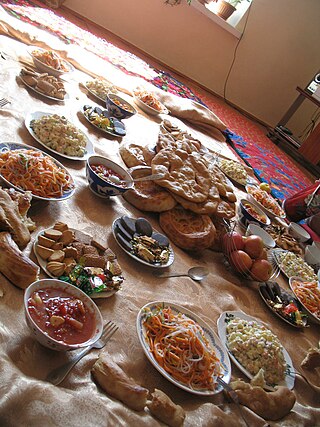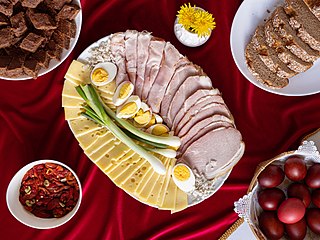
A cuisine is a style of cooking characterized by distinctive ingredients, techniques and dishes, and usually associated with a specific culture or geographic region. Regional food preparation techniques, customs, and ingredients combine to enable dishes unique to a region.
Breakfast is the first meal of the day usually eaten in the morning. The word in English refers to breaking the fasting period of the previous night. Various "typical" or "traditional" breakfast menus exist, with food choices varying by regions and traditions worldwide.

Shawarma is a Middle Eastern dish that originated in the Levant region of the Arab world during the Ottoman Empire, consisting of meat that is cut into thin slices, stacked in an inverted cone, and roasted on a slow-turning vertical spit. Traditionally made with lamb or mutton, it may also be made with chicken, turkey, beef, or veal. The surface of the rotisserie meat is routinely shaved off once it cooks and is ready to be served. Shawarma is a popular street food throughout the Arab world and the Greater Middle East.

Hollandaise sauce, meaning Dutch sauce in French, is a mixture of egg yolk, melted butter, and lemon juice. It is usually seasoned with salt, and either white pepper or cayenne pepper.

Maghrebi mint tea, also known as Moroccan mint tea and Algerian mint tea, is a North African preparation of gunpowder green tea with spearmint leaves and sugar.

Street food is food sold by a hawker or vendor on a street or at another public place, such as a market, fair, or park. It is often sold from a portable food booth, food cart, or food truck and is meant for immediate consumption. Some street foods are regional, but many have spread beyond their regions of origin. Most street foods are classified as both finger food and fast food and are typically cheaper than restaurant meals. The types of street food vary between regions and cultures in different countries around the world. According to a 2007 study from the Food and Agriculture Organization, 2.5 billion people eat street food every day. While some cultures consider it to be rude to walk on the street while eating, a majority of middle- to high-income consumers rely on the quick access and cheap service of street food for daily nutrition and job opportunities, especially in developing countries.

Central Asian cuisine has been influenced by Persian, Indian, Arab, Turkish, Chinese, Mongol, African and Russian cultures, as well as the culinary traditions of other varied nomadic and sedentary civilizations. Contributing to the culinary diversity were the migrations of Uyghur, Slav, Korean, Tatar, Dungan and German people to the region.
The Berber cuisine, though lacking a singular and standardized culinary framework, encompasses a diverse range of traditional dishes and influenced by the numerous flavours from distinct regions across North Africa. There is no consistent Berber cuisine, and it has been exposed to various influences. Berbers' meal choices were shaped by local availability of foods and personal finances. Berbers follow the same dietary laws and hygiene requirements as other Muslims. Ken Albala noted that "Describing meals as typically Berber is impossible–at best, they are samples of what is eaten in different regions by Berber families".

Ottoman cuisine is the cuisine of the Ottoman Empire and its continuation in the cuisines of Turkey, the Balkans, Caucasus, Middle East and Northern Africa.
Sierra Leonean cuisine consists of the cooking traditions and practices from Sierra Leone. It follows the traditions of other West African cuisines. The country has 16 tribal ethnic groups.
Diri djondjon is a native dish of Haiti. It is essentially a meal consisting of rice made with edible black mushrooms called djondjon. The meal is more common in the northern region of the country and therefore can be considered a regional specialty.
The global cuisine or world cuisine is a cuisine that is practiced around the world. A cuisine is a characteristic style of cooking practices and traditions, often associated with a specific region, country or culture. To become a global cuisine, a local, regional or national cuisine must spread around the world, its food served worldwide. There have been significant improvements and advances during the 20th century in food preservation, storage, shipping and production, and today many countries, cities and regions have access to their traditional cuisines and many other global cuisines.
This is a list of encyclopedias and encyclopedic/biographical dictionaries published on the subject of cuisine, cookery and chefs in any language. Entries are in the English language unless stated as otherwise.
Romani cuisine is the cuisine of the ethnic Romani people. There is no specific "Roma cuisine"; it varies and is culinarily influenced by the respective countries where they have often lived for centuries. Hence, it is influenced by European cuisine even though the Romani people originated from the Indian subcontinent. Their cookery incorporates Indian and South Asian influences, but is also very similar to Hungarian cuisine. The many cultures that the Roma contacted are reflected in their cooking, resulting in many different cuisines. Some of these cultures are Middle European, Germany, Great Britain, and Spain. The cuisine of Muslim Romani people is also influenced by Balkan cuisine and Turkish cuisine. Many Roma do not eat food prepared by a non-Roma.

Bulgur, or burghul, is a cracked wheat foodstuff found in West Asian cuisine.

Colleen Taylor Sen is a Canadian–American translator and author specializing in Indian cuisine. She has written or co-edited eight books and many articles and has also contributed entries to encyclopedias. Sen has given lectures at DePaul University, Indiana University, The Smithsonian Institute, The Oxford Food Symposia, K.R. Cama Oriental Institute (Mumbai), The National Council for Hotel Management and Catering Technology, The Indian International Centre, The Institute of Hotel Management, and other institutions.

The Good Huswifes Jewell is an English cookery book by the cookery and housekeeping writer Thomas Dawson, first published in 1585. It includes recipes for medicines as well as food. To the spices found in Medieval English cooking, the book adds herbs, especially parsley and thyme. Sugar is used in many of the dishes, along with ingredients that are uncommon in modern cooking like violets and rosewater.

Balkan cuisine is a type of regional cuisine that combines characteristics of European cuisine with some of those from Western Asia. It is found in the Balkan Peninsula of Southeast Europe, a region without clear boundaries but which is generally considered to at least include the modern countries of Albania, Bulgaria, Turkey, Romania and Greece and the former Yugoslavia, with the possible exception of Slovenia and northern inland regions of Croatia.

Rabbit stew, also referred to as hare stew when hare is used, is a stew prepared using rabbit meat as a main ingredient. Stuffat tal-Fenek, a variation of rabbit stew, is the national dish of Malta. Other traditional regional preparations of the dish exist, such as coniglio all'ischitana on the island of Ischia, German Hasenpfeffer and jugged hare in Great Britain and France. Hare stew dates back to at least the 14th century, and was published in The Forme of Cury during this time as a recipe for stewed hare. Rabbit stew is a traditional dish of the Algonquin people and is also a part of the cuisine of the Greek islands. Hare stew was commercially manufactured and canned circa the early 1900s in western France and eastern Germany.

The Virginia House-Wife is an 1824 housekeeping manual and cookbook by Mary Randolph. In addition to recipes it gave instructions for making soap, starch, blacking and cologne.













